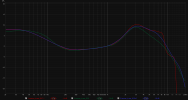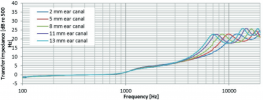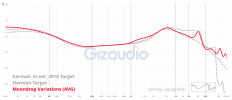@IAtaman I find Harman in-ear too intense in the gain region as well. A lot of people do. And even stuff like the Dusk, Variations, Monarch Mk2, which are among the
most Harman compliant IEMs in existence, pull it back a bit in that region. I don't find Harman too intense there at all with over-ears, it's fine there.
With in-ears though it is initially impressive what it does for clarity, but with longer listening often tends to get a bit too much and become fatiguing. Not "totally unbearable", but just a bit too much, too shouty. This is a very common sentiment with Harman IE, much more than with the over-ear target which has far wider acceptance without modification. I wonder if this is part of the issue so many people have with Harman's research for the IE curve, because I like the curve at first listen too, it's a sort of Coke vs Pepsi Challenge situation, it sounds better initially but only becomes fatiguing with extended listening.
Two example IEMs I find a bit too shouty, that are highly compliant with Harman in this region, are the Tripowin Olina and Samsung Galaxy Buds+. Again, not intolerable, I still think both of these are good IEMs. But a bit more than my ideal. Tripowin revised this with the Olina SE which reduces that region and it's much better for it. A very popular mod with the OG Olina was to put a different filter on it (from the Tanchjim Tanya), this also reduced that region. There seems to have been this very widespread feeling from the community that it was too much, and I agree with that personally. Samsung also reduced the region in their Buds series after the Buds+, which I also found positive in the Buds Pro and Buds 2. Buds 2 Pro has similar above 3kHz but less 1-3kHz, I don't think I find this particularly problematic so far but I suspect I could take a little less.
Jaakko of AutoEQ has the Olina as his seventh most Harman compliant IEM in existence with 84, he has the Buds Plus way down with only 76 but I have no idea why as it is extremely close to Harman.
View attachment 268745



